|

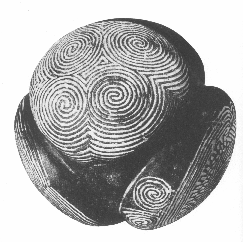 Carved
Stone Balls:
(Petrospheres) Carved
Stone Balls:
(Petrospheres)
These small, carved stone balls are
distinctly Scottish objects, with over 425 known. Most have been found
in Aberdeenshire. They are similar in size and a few are decorated with
spirals and curved motifs.
While most carved balls
are Scottish objects, several have been discovered in Orkney and a few
have been found on Skye, Iona, Lewis, Harris and Uist. In addition, some
have been uncovered in Ireland and England.
(1)
Mathematicians are interested in Carved
Stone Balls because of their aesthetic beauty as they have amongst them
all the symmetrical forms of the five Platonic solids.
Carved stone balls have been found
with as many as 160 knobs, but six is the most common number.
| The
Scottish Carved Stone Balls: |
They first began to appear at around 1850, with all
examples being made of stone except a single bronze specimen from Lanarkshire
(2)
Very few have been found in secure archaeological contexts and their
dating was hotly debated for many years - it was once suggested that
they were Saxon. However, examples have been found during excavations at
the later Neolithic settlement at Skara Brae, Orkney. The decoration on
many of the balls is similar to that on other artefacts of the period,
such as Grooved Ware pottery and passage tomb art.
The balls can be quite elaborate; the
most common ones are those with six projecting knobs, which may be plain
or decorated. They are usually very similar in size
(3). Of 387 balls known at the time
of Marshal's exhaustive study, 375 were 'much the same size, with a
diameter of 70mm, 12 large balls of 90-114mm and 7 oval balls'. The
uniformity of size is one of the most remarkable features of the balls,
although they display a wide variety of treatments.
(4)
Carved stone balls as high-status
objects:
If we look to the burial record for
later prehistory we find that the burials in monuments represent just a
small percentage of the population. Although we do occasionally find
what might be described as 'high status' objects interred with the body
of the deceased (the stone mace-head with bone-decorated handle from
Bush Barrow for example), not a single carved stone ball has been found
in this context. They invariably come to light as stray finds in farmers
field (with a handful of exceptions), and never from a context that
would indicate any elevated status.
|
Carved Stone Balls: Some Examples.
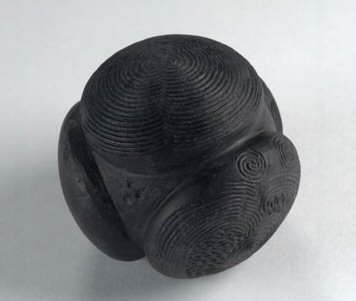
Towie,
Aberdeenshire: This carved stone ball (3.00"
diameter), was found at Glass Hill, Towie in Aberdeenshire. It dates
from between 3200 and 2500 BC.
The 'Towie'
ball has four knobs, three of them decorated with spirals or dots
and rings. The designs closely resemble those pecked into the
stones of the passage mound at Newgrange
in Ireland.
Carved stone
balls are distinctly Scottish objects, with over 425 known. Most
have been found in Aberdeenshire. They are similar in size and a
few are decorated with spirals and curved motifs. The Towie ball
is an exceptionally fine example.
(1)
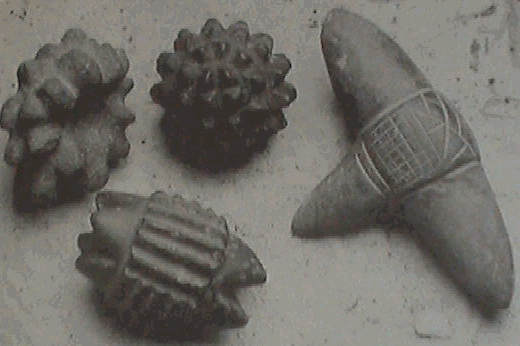 Skara
Brae, Orkneys: Skara
Brae, Orkneys:
Perhaps the most important
discovery of carved stone balls was made at the Neolithic settlement
at Skara Brae in Orkney. The
excavations there provide a contextual date placing them firmly in
the Neolithic. Furthermore, it was one of the very few occasions
when more than one ball was recovered. They are usually encountered
as stray finds as a result of agricultural activity. Therefore Skara
Brae provides a wonderfully rich context for these objects, as they
were found in context with other ground stone tools and in-situ at a
Neolithic habitation site.
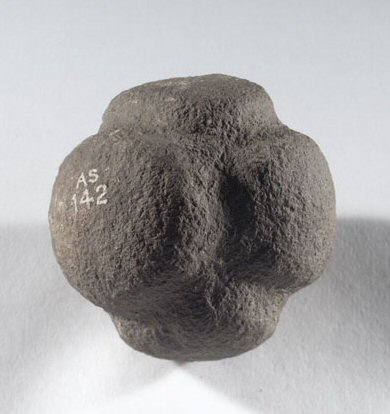
Braes of Biffie, Buchan, Aberdeenshire:
The six projections, and roughened
surface of this Greenstone ball are typical of the majority of
carved stone balls. Almost half of all known carved balls have six
projections and most were not finished to the high standard of the
'Towie' ball (Above). |
|
The Platonic Solids.
Some researchers have suggested that carved stone balls were attempts to
realise the Platonic solids. There are five (and only five) Platonic
solids (regular polyhedra). These are: - the tetrahedron (4 faces),
cube (6 faces), octahedron (8 faces), dodecahedron (12 faces) and icosahedron (20 faces). They get their name from the ancient Greek
philosopher and mathematician Plato (c427-347BC) who wrote about them in
his treatise, Timaeus.

The Greeks
taught that these five solids were the core patterns of physical
creation. Four of the solids were seen as the archetypal
patterns behind the four elements (earth, air, fire, and water),
while the fifth was held to be the pattern behind the life force
itself, the Greeks' ether. These same shapes are now realised to be intimately
related to the arrangements of protons and neutrons in the
elements of the periodic table.
(5)
The Platonic solids can be traced onto the
surface of a sphere through a process called radial projection, with
each face having the same angles and shape. Carved
stone balls come in many shapes, but most have bosses equal to the
number of faces on the Platonic solids. Their makers were generating
spherical objects with maximal symmetry. The number of bosses
on the balls as listed by Marshall, were analysed by Manoel de Campos
Almeida, a professor of mathematics who is interested in the Platonic
solids. He determined that the number of bosses was not randomly allocated
(over 75% of all carved stone balls have a number of bosses that equates
with one of the five Platonic solids) proving mathematically that
Neolithic people were able to count to at least 135 and were radially-projecting
the Platonic solids (and their duals) in the hardest material available
to them at the time, some 1500 years before Plato wrote about them in
Timaeus. (The
Harmony of the Spheres) |
Gallery
of Images:

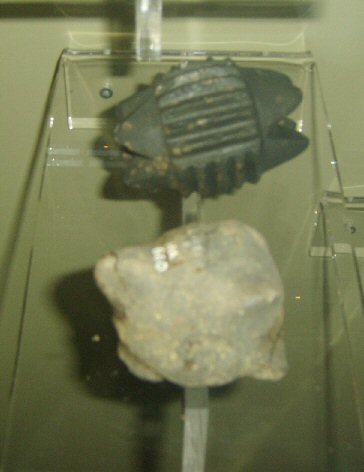
Petrospheres from the Orkneys.
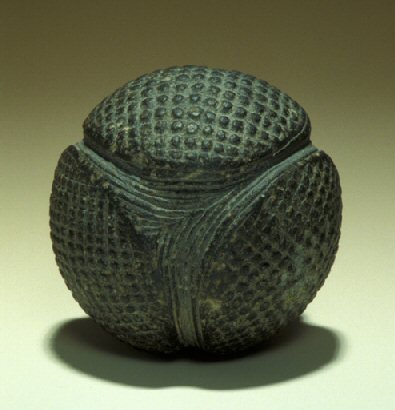
Photo Credits: University of Aberdeen.
( Images
from Glasgow Museum Collection)
(Article:
Archaeological Data Service 1976-77)
(Petrospheres Homepage)
(Costa Rica Balls)
(Orkney's Homepage)
(Other Scottish Prehistoric Sites)
|
 Carved
Stone Balls:
Carved
Stone Balls:
 Skara
Brae, Orkneys:
Skara
Brae, Orkneys:

